12 Yoga Poses You Can Practice Against a Wall

(Photo: Andrew Clark)
As an introvert, I have nothing but nice things to say about living alone. The thermostat is set to my comfort, I can play my music at whatever decibel suits me, and I can always be assured that the last slice of pizza is mine. But while I cherish my independence, there are times when having the support of another person would be welcomed. There’s nothing to remind you that you’re on your own like trying to clasp your own bracelet.
In American culture, where independence is highly valued and even romanticized, we like to do our own thing in our own way. This can make it hard to ask for or accept help. But, as the song goes, “we all need somebody to lean on.”
Why We Need Support
Social support is critical to our well-being. People who have people they can count on tend to have better physical and mental health. According to research, social isolation and loneliness have been associated with higher risks for conditions such as hypertension, heart disease and obesity, as well as anxiety, depression, and cognitive decline. The correlation between social support and mental health is especially acute for women, older adults, and students, some studies suggest.
For many of us, it’s not that we don’t have a support system; it’s that we’re not paying attention to where our support is coming from. Negativity bias may cause us to focus more on the people who don’t “have your back” than on the positive support group that does.
In some cases, fierce independence may actually be a trauma response. If people in your life have been untrustworthy or the source of harm, your fear of being hurt again may make you unconsciously resistant to asking for help, or cause you to refuse help that’s offered.
What Yoga Philosophy Says About Support
If your sense of pride keeps you from asking for help, that may be an invitation to contemplate the yoga concept of asmita, which can be translated as ego attachment. That can make you want to hold too tightly to an “I got this!” attitude. While confidence and self-sufficiency are certainly desirable traits, the principles of yoga encourage the cultivation of humility that allows you to accept and appreciate gifts of assistance and support.
“One of the best antidotes to this tendency is to practice expanding our sense of self by including others in our personal territory,” writes Sally Kempton in a Yoga Journal essay. That may mean offering a kindness or seva (service) to someone. But it can also mean being open to accepting offerings from others.
You may cultivate this openness by meditating on the well-being of yourself and others. Try Tonglen meditation, which translates as “giving and taking” or “sending and receiving.” “It is a practice that encapsulates loving kindness, compassion, forgiveness, gratitude, and generosity,” says yoga and meditation teacher Jacobi Ballard.
Your asana practice can support you along the way. The sequence below offers familiar poses against the wall as a subtle reminder that support is available. In yoga, as in life, practicing this way doesn’t mean you won’t have challenges. The poses require similar muscle strength, mobility, and balance as poses practiced in the middle of a room. But having the wall as a steadying, supportive touch point can make for a strong, rewarding practice.
RELATED: How Tonglen Meditation Can Help You Build a Loving Relationship to the World
12 Yoga Poses to Do at the Wall
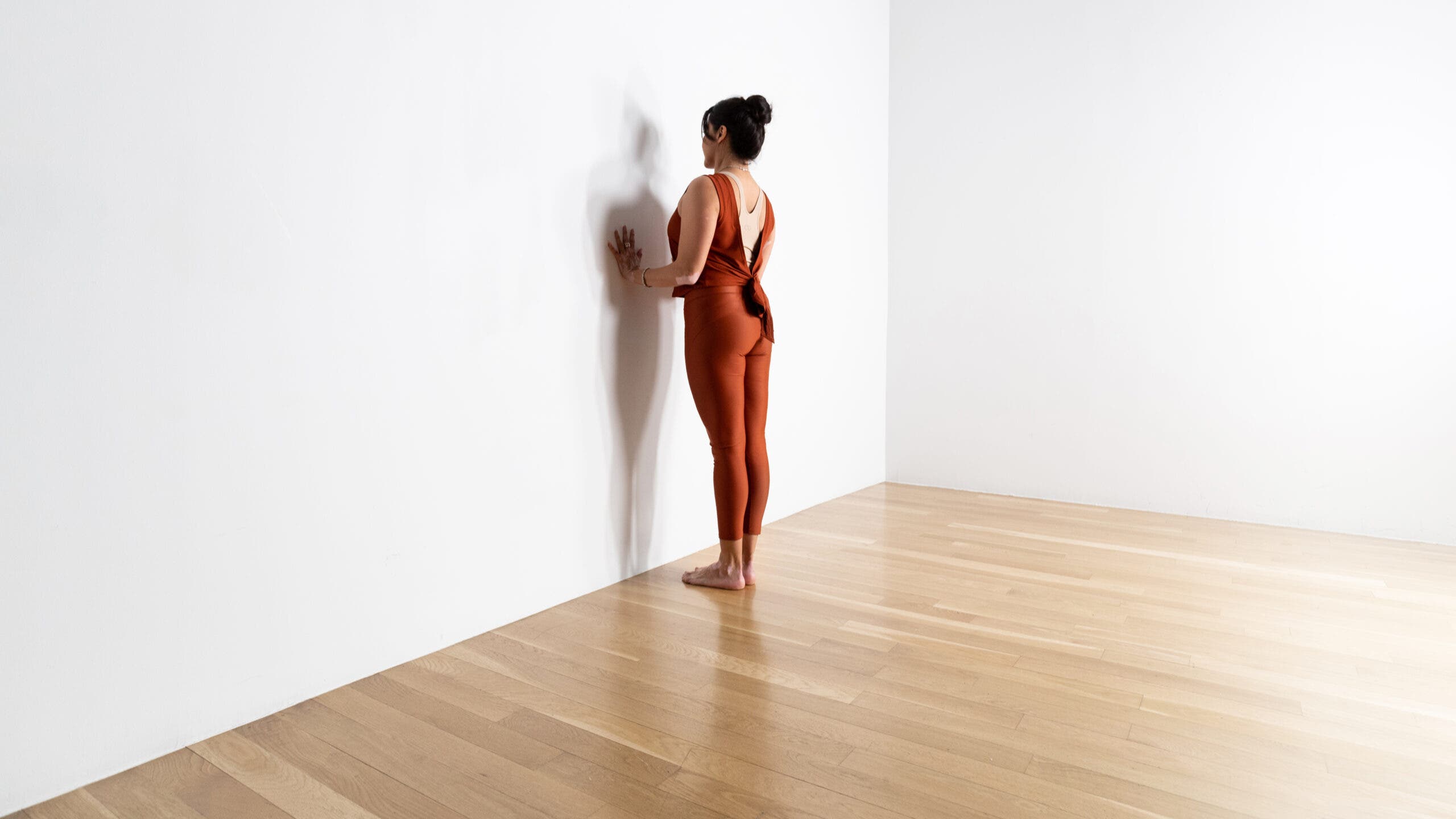
1. Four-Limbed Staff Pose (Chaturanga Dandasana)
Face the wall with your toes a few inches away. Bend your elbows and place your fingertips on the wall at waist height. Bring your upper arms in close to your sides, with your elbows pointing back. Allow your shoulder blades to move down and in toward each other. Root your feet into the ground, engage your abs, and lengthen your spine in Chaturanga. Level your chin parallel to the floor and cast your gaze slightly down. Stay for 3-5 breaths.
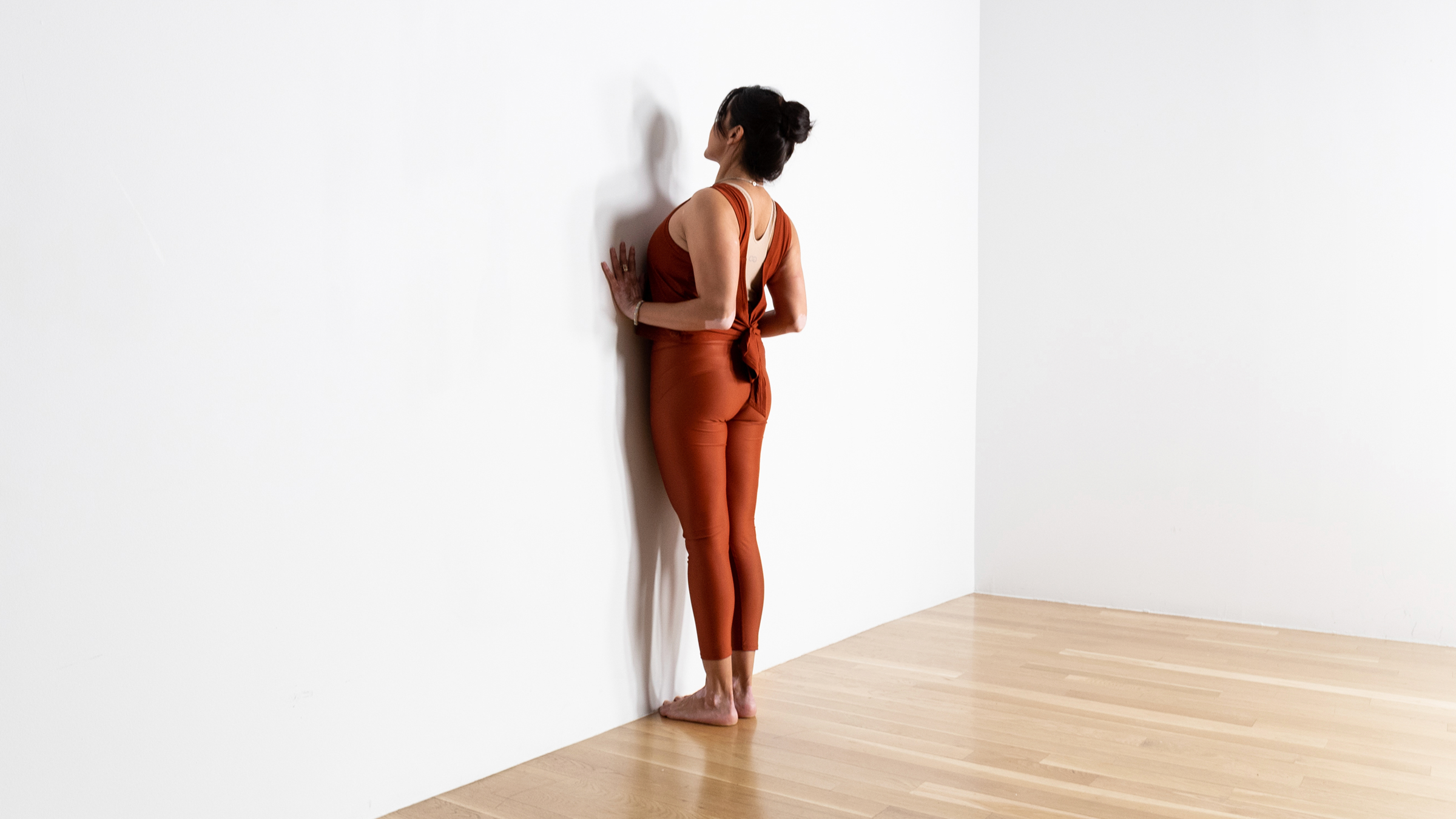
2. Cobra Pose (Bhujangasana)
From Chaturanga at the wall, step forward so that your toes are touching the wall. Keep your hands at chest level. Press your chest toward as you lift your sternum up, slightly arching your back in Cobra. Look up toward the ceiling but keep space along the back of your neck. Stay for 3-5 breaths.
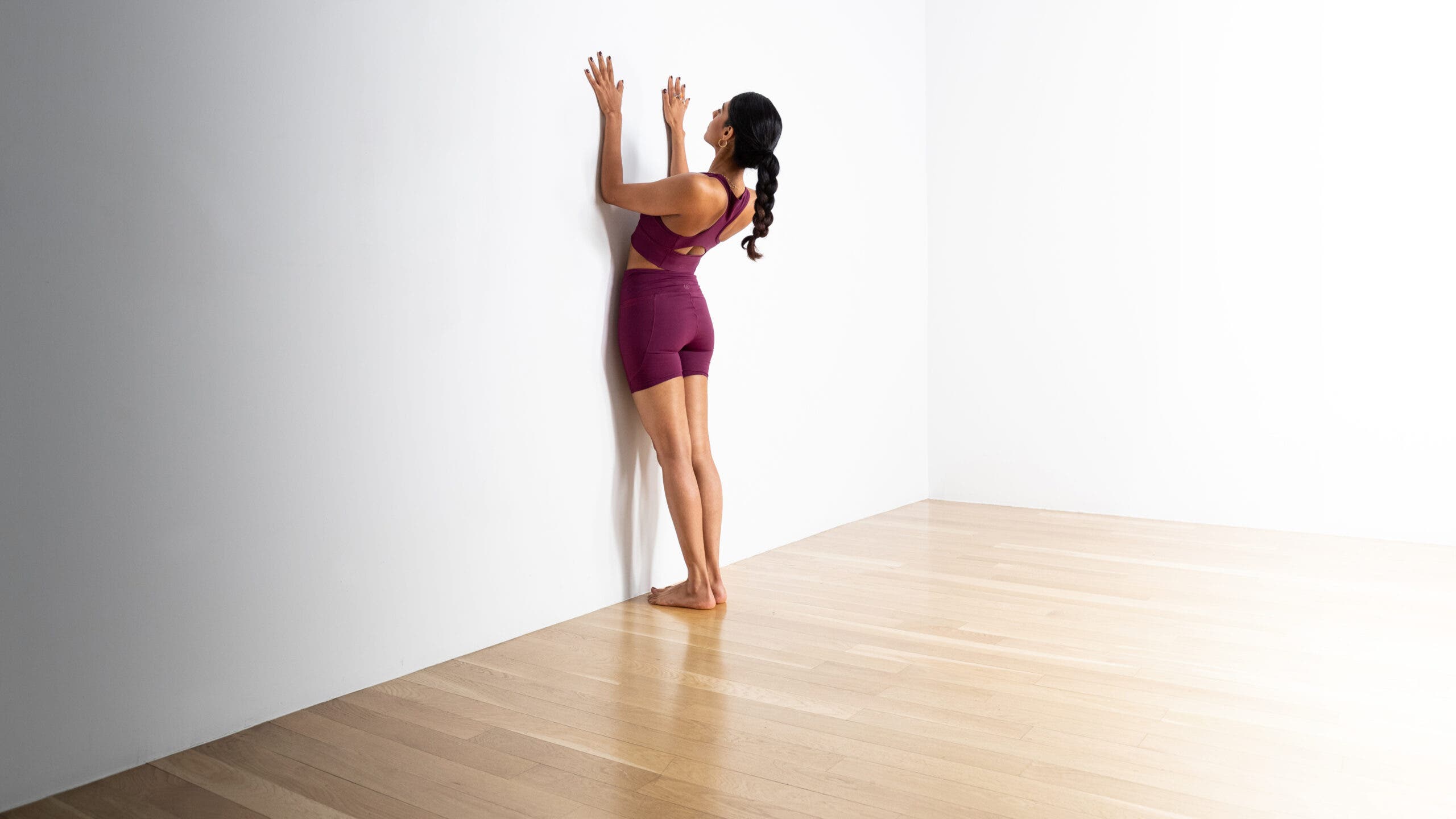
3. Sphinx Pose (Salamba Bhujangasana)
From Cobra at the wall, walk your hands up and place your forearms on the wall with your elbows a little higher than your shoulders. Press your hips toward the wall as you lift your sternum and take an even deeper arch in your back in Sphinx Pose. Look up, keeping length along the back of your neck and an even curve along your spine. Stay for 3-5 breaths.
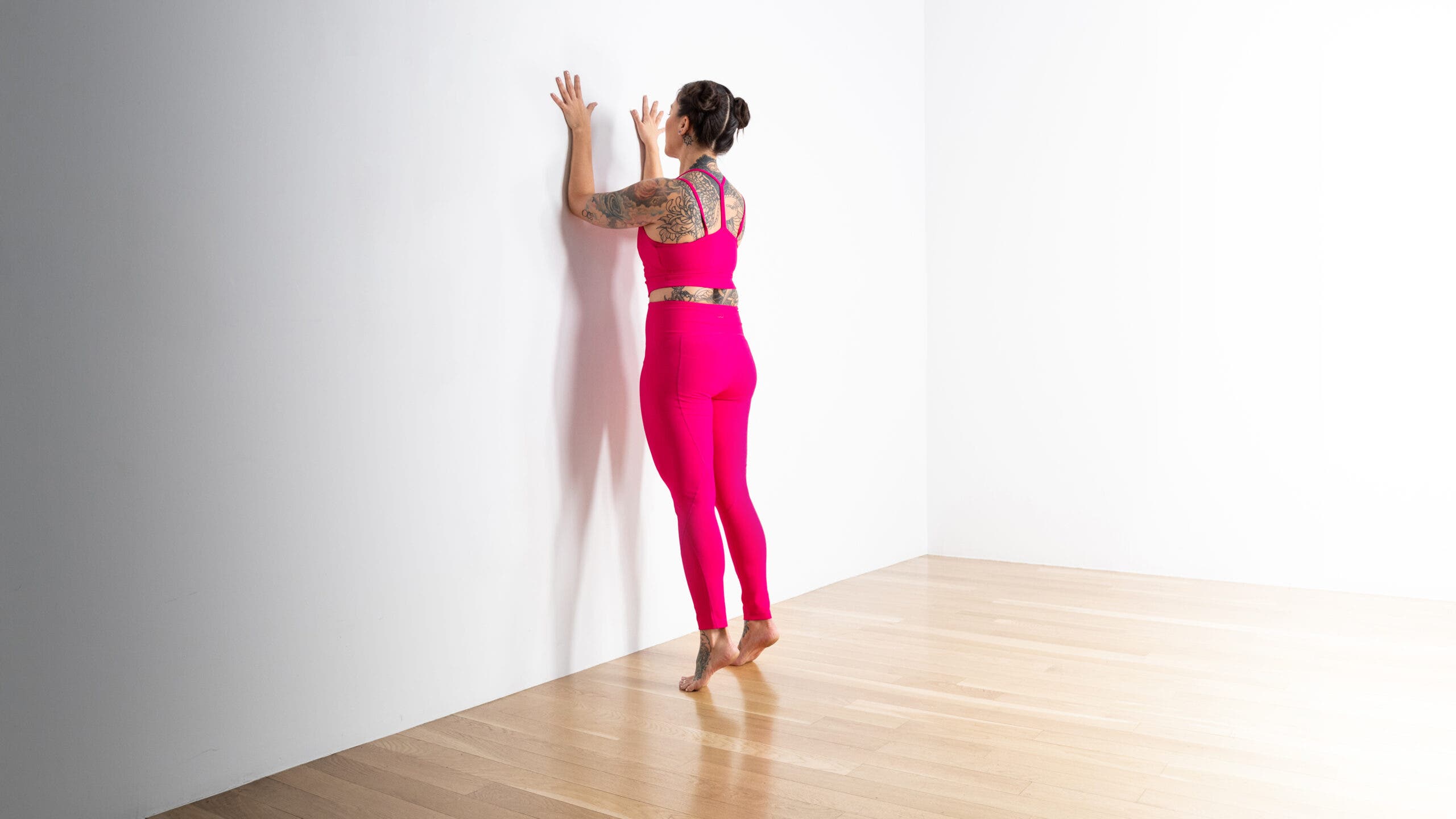
4. Forearm Plank
From Sphinx Pose at the wall, step back the distance of one foot, keeping your forearms on the wall. Engage your abs, lift your heels off the floor, and come onto your tiptoes. Press into the wall with your arms, finding space between your shoulder blades. Gaze straight ahead at the wall in Forearm Plank. Take 3-5 breaths, then lower your heels.
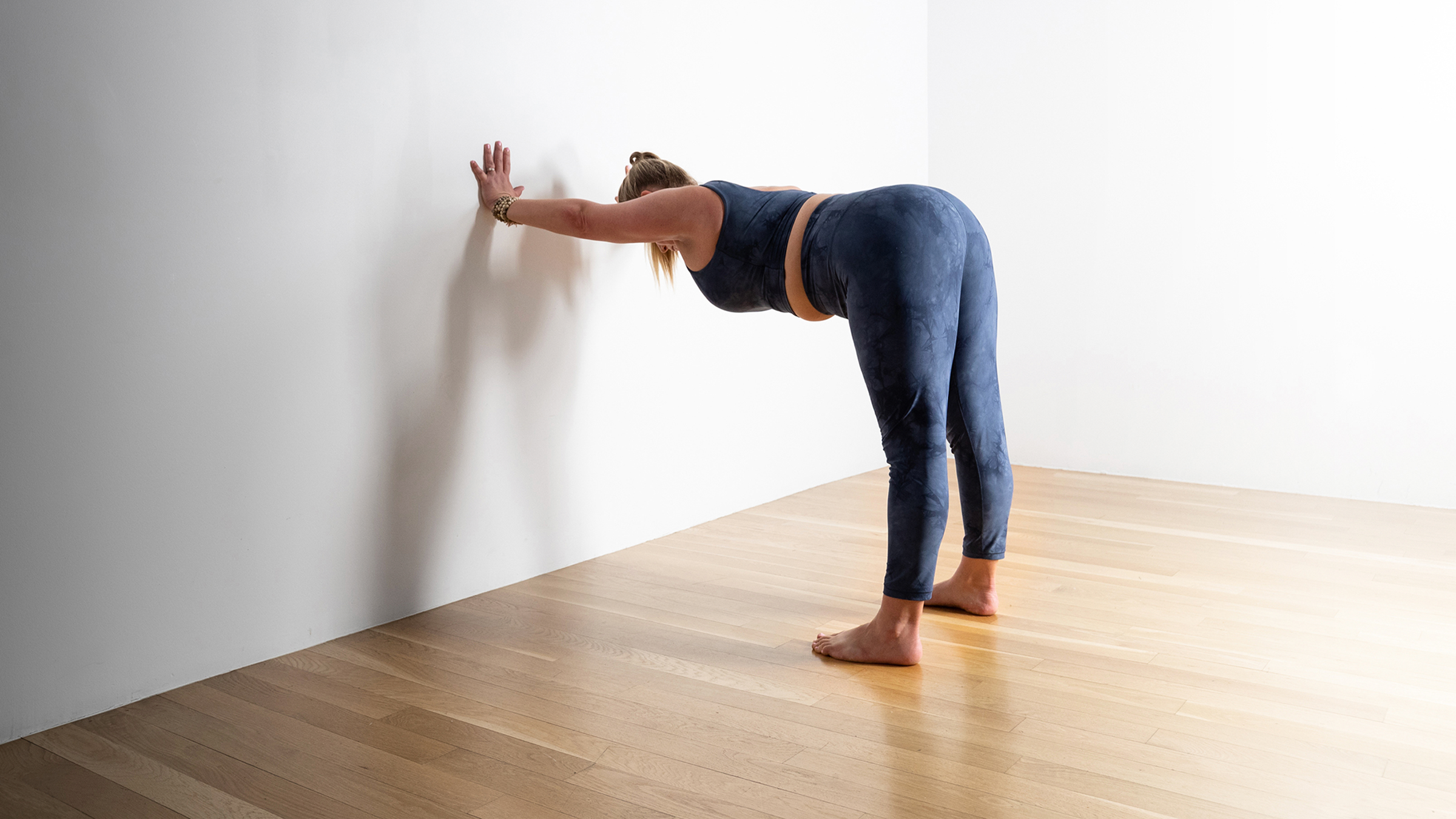
5. Downward-Facing Dog Pose (Adho Mukha Svanasana)
Step back 2-3 feet from the wall. Set your feet hip distance apart and press your feet into the floor. Hinge at your hips and fold forward halfway, reaching your arms out long to place your hands on the wall, fingers pointing up. Adjust your stance as necessary so that your arms are fully extended, your back is long, and your hips, knees, and heels are stacked. Your torso and legs will form a right angle as in Downward-Facing Dog Pose. Gaze straight down and breathe 3-5 times. When you are ready, step forward, release your hands, and return to standing.
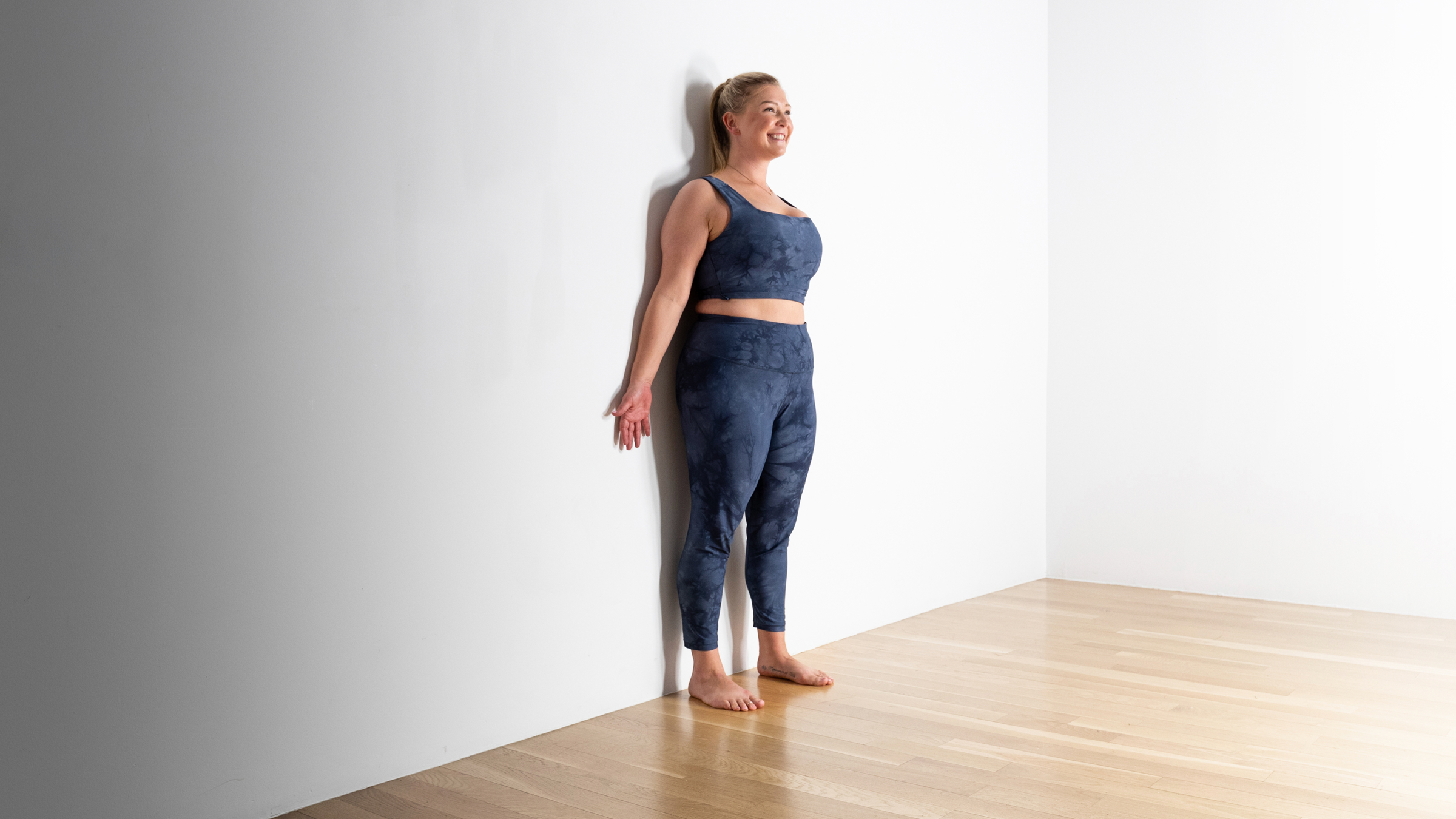
6. Mountain Pose (Tadasana)
From Down Dog at the wall, turn and stand with your back to the wall. Step your feet hip-width apart and an inch or two away from the wall. Your glutes, shoulder blades, and the back of your head may graze the wall. Reach the crown of your head toward the ceiling, relax your shoulders away from your ears, and allow your hands to reach toward the floor, palms facing away from the wall in Mountain Pose. Breathe. Make note that you are supported by the wall, but not leaning your weight into it. Breathe.
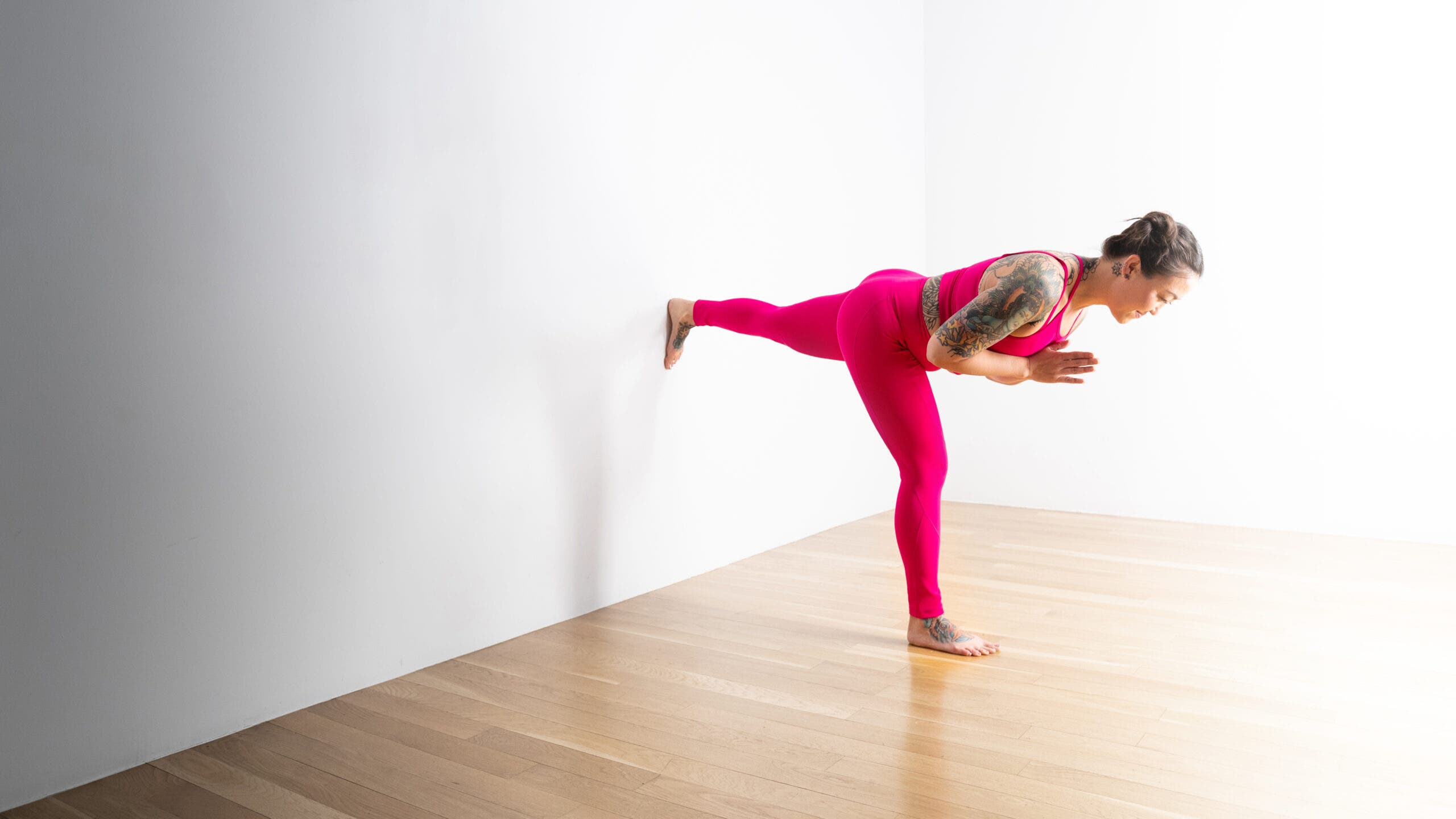
7. Warrior 3 Pose (Virabhadrasana III)
Step away from the wall approximately 2-3 feet. Place your feet hip-width apart and set a block at the outside of each foot. Keeping your back long, begin to lean forward and lift your left leg straight back so your body is one long line. Adjust your stance as necessary, so that the sole of your foot can make full contact with the wall. Press your foot against it, toes down, in Warrior 3 Pose. Reach down and rest each hand on a block.
For an extra challenge, release one hand, then the other from the blocks and bring them into prayer position (anjali mudra) at your heart, out to the sides parallel to the floor, or extend them back toward your feet.
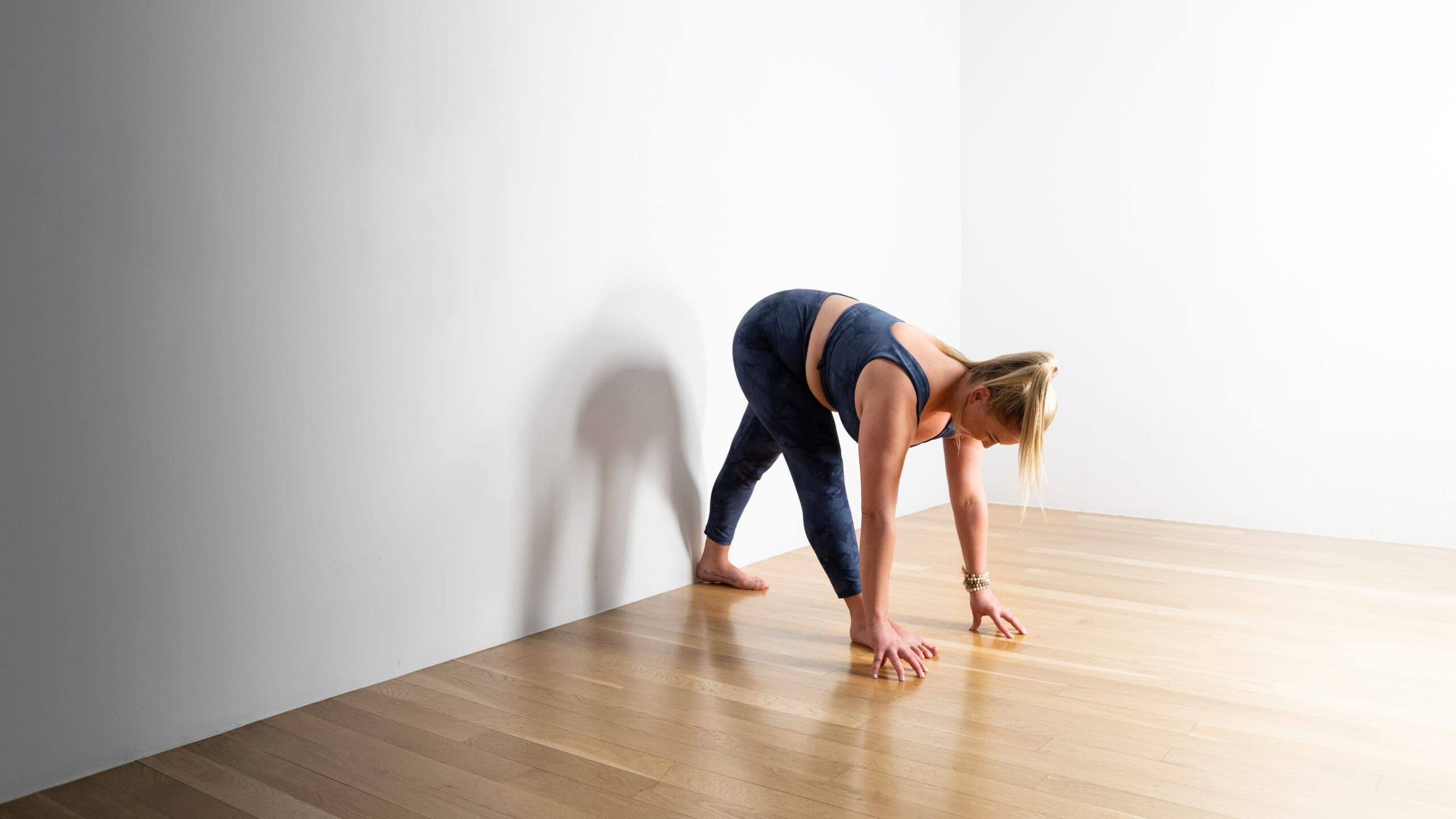
8. Pyramid Pose or Intense Side Stretch (Parsvottanasana)
From Warrior 3, lower your right leg and place your right foot on the floor with your heel at the wall. Adjust your left foot so that your feet are 2-3 feet apart. Fold forward and place your fingertips on the floor or blocks in Pyramid Pose. Take 3-5 breaths.
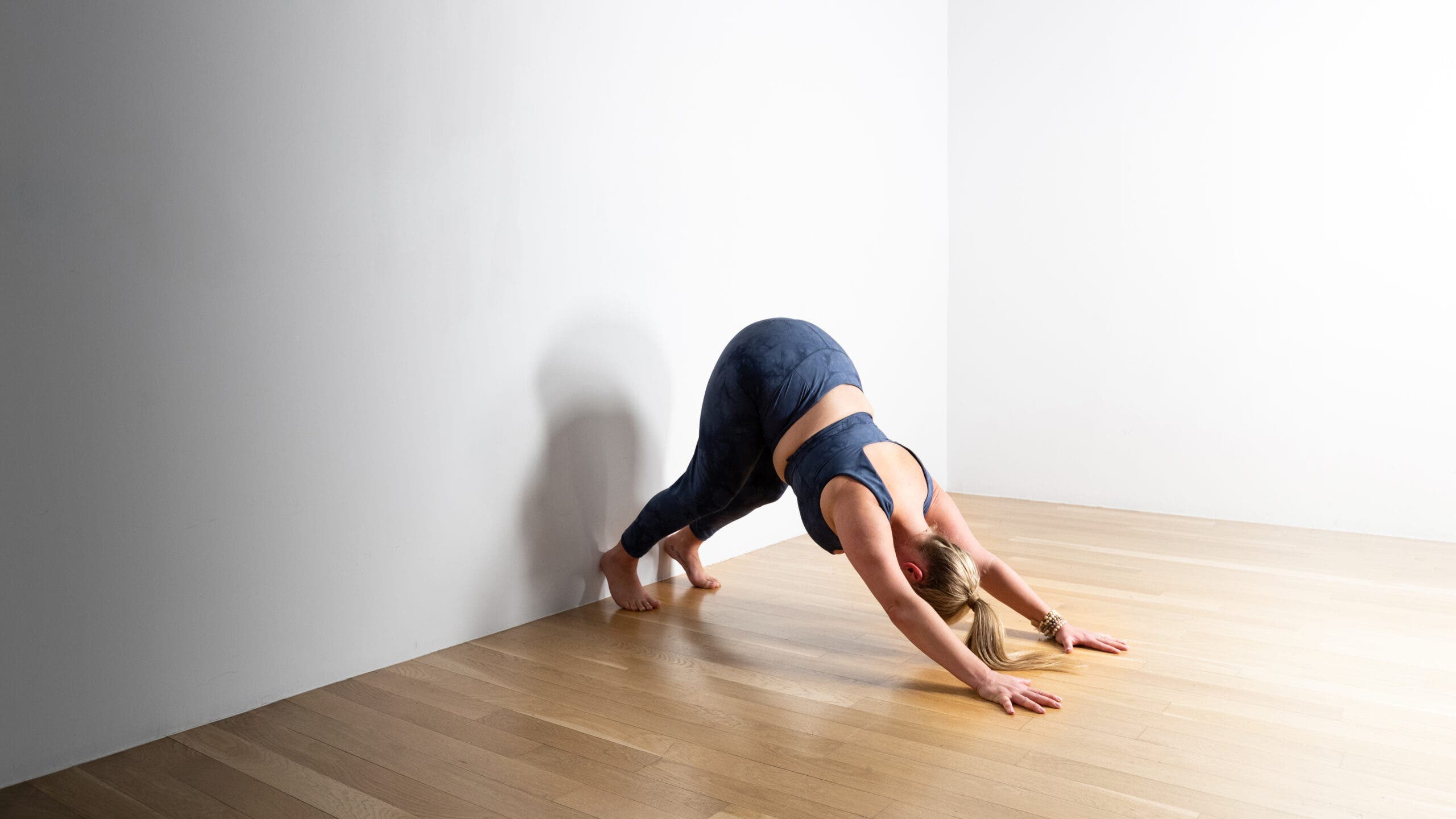
9. Downward-Facing Dog Pose (Adho Mukha Svanasana)
From Pyramid, shift your weight into your hands and step your left leg back to meet the right at the wall. Walk your hands forward as needed to make the shape of Down Dog. When you are ready, bend your knees, take a step forward, and walk your hands toward your feet to come into a standing forward fold. Roll up to return to Mountain Pose and repeat Warrior 3 Pose, Pyramid Pose, and Down Dog on the opposite side.
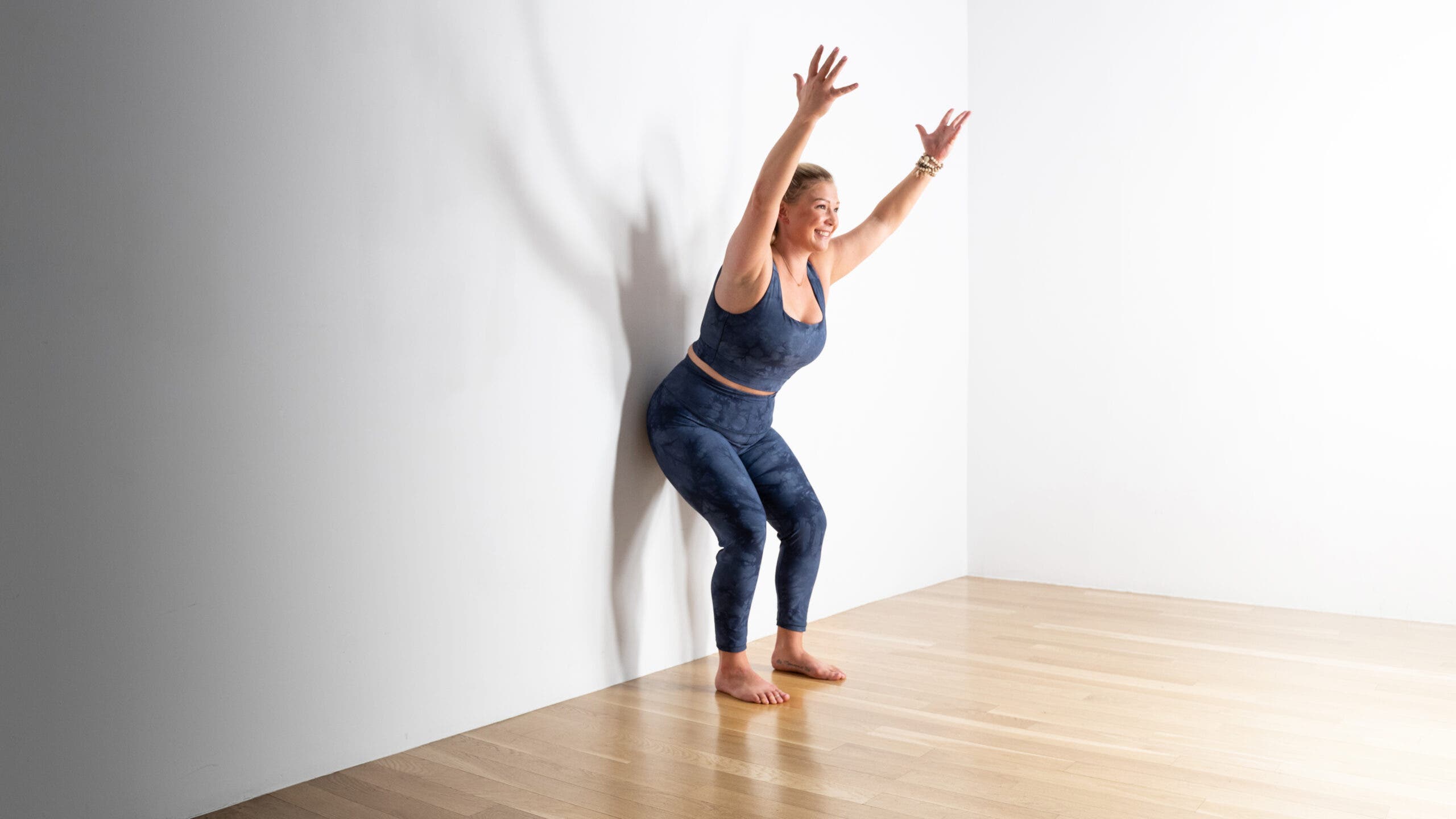
10. Chair Pose (Utkatasana)
Stand about a foot from the wall facing away from it. Bend your knees and reach your tailbone back until your backside touches the wall. Engage your abs as you lengthen your spine to create space in your lower back. Lean slightly forward and raise your hands up parallel with your ears in Chair Pose. Stay for 3-5 breaths, using the wall as a touch point, but not leaning your weight on it.
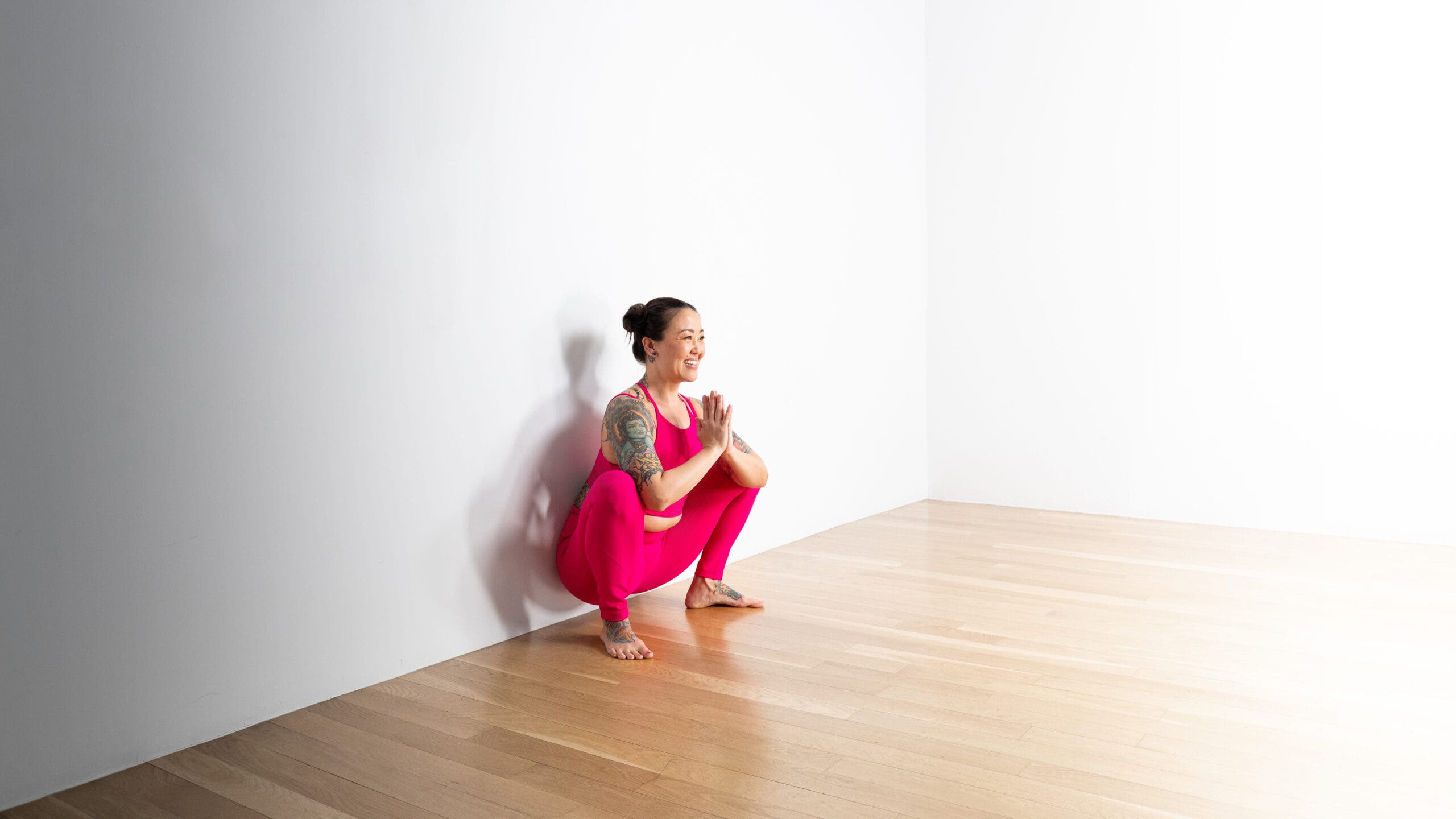
11. Garland Pose (Malasana)
From Chair, step your feet a little wider and turn your toes out. Bring your hands to prayer position at your heart. Bend your knees more deeply and lower your body down into a squat. Allow your glutes to graze the wall and provide support as you lower toward the floor. Adjust your feet as needed, supporting yourself by pressing your hips back into the wall or placing your hands on the floor in front of you in Garland Pose. When you’re ready, lower your hips all the way to the floor to sit with your back against the wall.
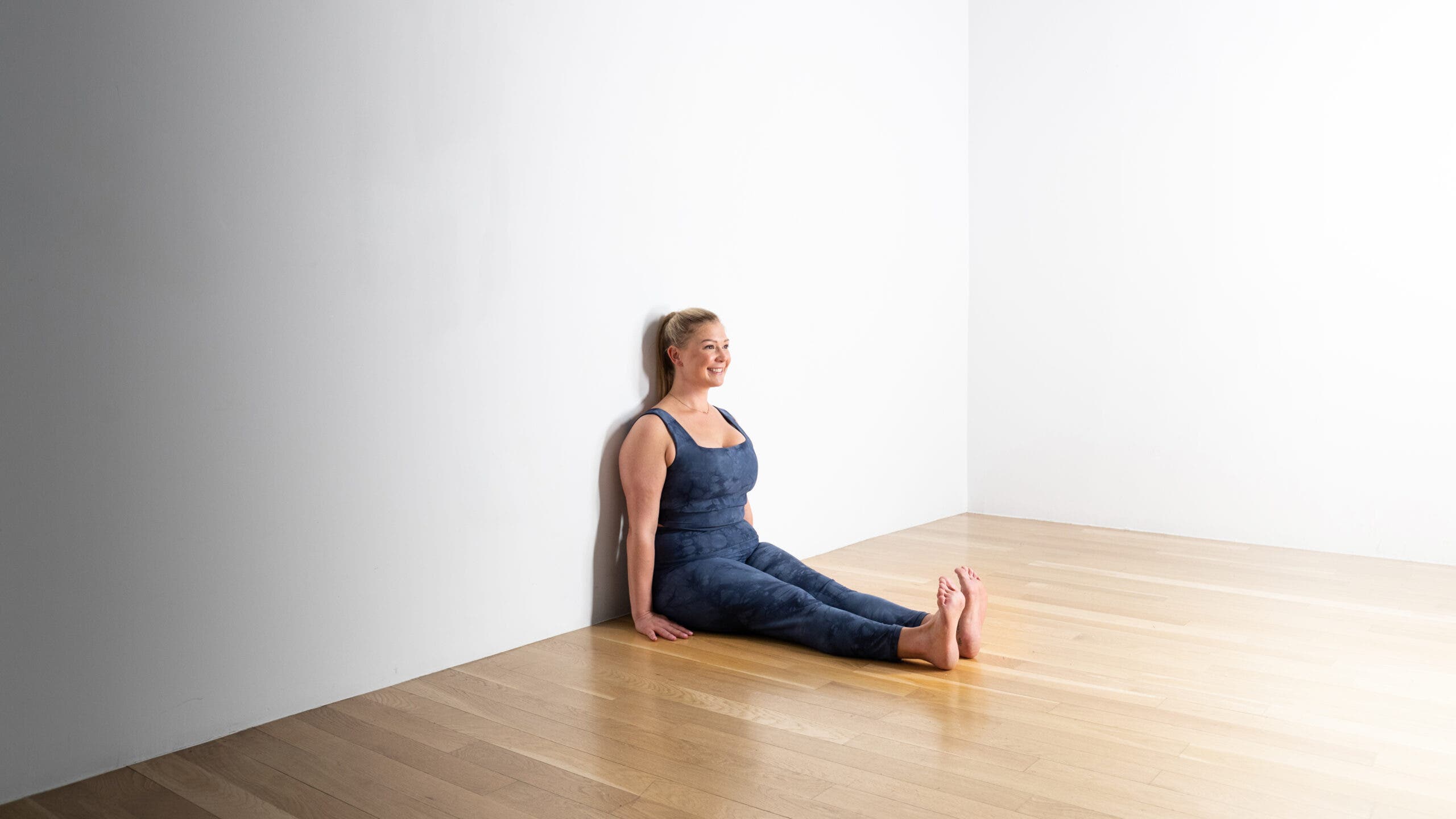
12. Staff Pose (Dandasana)
Extend your legs straight in front of you, bringing your feet about hip-distance apart, flexed with your toes pointing toward the ceiling. Adjust your position so that you are sitting evenly on your sit bones and the upper part of your glutes are in contact with the wall. Your shoulder blades and the back of your head may also graze the wall. Reach the crown of your head toward the ceiling to lengthen your spine and place your palms on the floor alongside your hips. Engage your thighs and abs, move your shoulders down away from your ears, and sit tall and erect with your gaze cast toward your feet in Staff Pose. Stay here for 5 or more breaths.
When you are ready, take a deep breath and, on an exhalation, relax your muscles, close your eyes, and bring your hands to rest on your thighs or in your lap. Sit and breathe for a few moments until you are ready to end your practice.